What Does Google Think About Your Freelance Copywriter Website?
If your freelance copywriter website is done, congratulations! Whether you paid a developer/designer to build your freelance copywriter website or went with the DIY option, I’m sure it cost more or took longer than initially expected.
You’ve had to make decisions about everything, such as choosing the best template, color schemes, images, and fonts. And now that it’s done, you can breathe a massive sigh of relief, right?
Well, that depends…
If your site aligns with Google’s preferences and requirements, then the answer is yes!
Unfortunately, many people never check their website to see what Google “thinks” about it — meaning how well you match their preferences and requirements. And while the Google Ranking Algorithm is shrouded in secrecy and kept under lock and key, you can get a free peek via the Google PageSpeed Insights tool.
What Is the Google PageSpeed Insights Tool?
The Google PSI tool is a free service that lets anyone quickly check a website’s Page Load Speed and many other vital ranking factors in minutes.
Page Load Speed became a ranking factor in 2010 and remained unchanged until 2018, when it was expanded to include mobile results as part of the ranking formula. The most recent update came in 2021, introducing Core Web Vitals that use only the mobile version of a website for scoring purposes.
Now, with that brief history lesson over, let’s find out what Google really thinks about your freelance copywriter website. You can follow along as I use the Google PageSpeed Insights tool to analyze my website as an example.
To start, follow this link: https://pagespeed.web.dev
Once the page loads, enter your website URL into the query box and hit the analyze button.
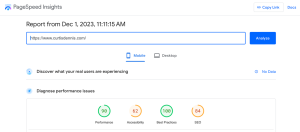
As you can see, I don’t have enough traffic to generate a Chrome Real User Experience report, a topic for another day. You can check your desktop score by clicking its icon but remember that only the mobile version matters to Google. So, click back to the mobile option, and let’s continue.
The maximum score for each category is 100, so Google appears to “like” my website. But there is always room for improvement, as you can see by my accessibility score of just 62. More on that in a moment.
Performance
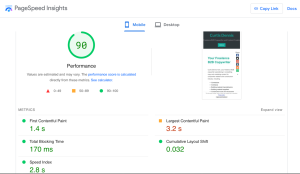
You can see that the scores are color-coded like a stoplight, so we don’t want to see any yellow or red text with these metrics. An overall performance score of 90 out of 100 is pretty good, but let’s look at each metric individually.
First Contentful Paint (FCP) is the time between when the page starts to load and when any part of the page content appears on the user’s device. Google wants that to happen in less than two seconds to receive a green score.
Largest Contentful Paint (LCP) is the amount of time from when the user initiates page loading by clicking a link until the most prominent image (typically the header image) or largest text block (typically the main content) appears on the user’s device. Similar but different than the FCP factor.
Total Blocking Time refers to the amount of time after the FCP until the user can enter inputs such as click, taps, scroll, or zoom, which are typically connected to JavaScript performance.
Speed Index measures how quickly page contents are visually populated, based on the user device screen size. The lower this score, the better.
So, what should I do about my low (red) LCP score?
Scroll down your screen past the Treemap section, and Google will give you a list of opportunities to improve your ranking components like this.
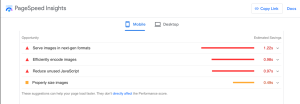
Click on the arrow in the Estimated Savings column to see a drop-down list of specific items that require attention.
I’m getting dinged a bit for using .jpg and .png images since Google would prefer those images to be WebF or AVIF formats for improved compression and faster loading speeds.
My nav bar images have a defined width, but the height is set to “auto.” I’m unsure how that happened, but I must specify the image height.
I also have some excessive JavaScript being used on my Facebook follow button that I need to investigate.
Properly sized images mention that unspecified height in my nav bar images again.
Accessibility
Web accessibility, or eAccessibility, refers to any website barriers that prevent access to or interaction with people with situational disabilities, physical disabilities, or socio-economic restrictions on speed or bandwidth.
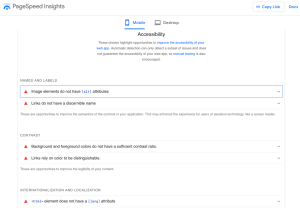
With a yellow score of 62, I have some issues to address very soon.
According to PSI, my website uses two images with missing alt tags. Text-to-speech editors use these tags to describe images to visitors who are blind or otherwise visually impaired. Without an alt tag, the editor can indicate that there is an image but can’t describe it.
It appears that my social media menu links aren’t discernable. I might need to replace that # with an actual name. But since that’s an SBI (SoloBuildIt — the website platform I use) feature, I’ll need to contact support for more information.
I need to adjust my link colors to contrast more against the page background and surrounding text.
And lastly, add a language attribute to my <html> page tag.
Best Practices
This score reflects the trust and safety your website provides to visitors and their Personally Identifiable Information (PII).
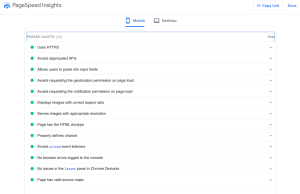
I must ensure that CSP is effective against cross-site scripting (XSS) attacks. This is entirely new to me, so I clicked the arrow and found a helpful guide, how to use a CSP to prevent XSS link. Looks like I’ve got some reading to do this weekend.
SEO
Perhaps my favorite category, but I am dismayed that my SEO score has dipped below 90.
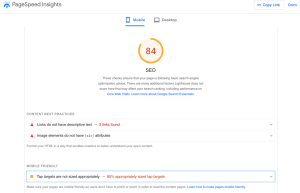
The items listed here, missing descriptive text and alt tags, were mentioned before in previous sections. The tap targets refer to that social media icon bar that is noticeably smaller on a smartphone than a computer screen, so I’ll add that to my to-do list.
To Wrap It Up
You can use this tool to check any website, not just your own. I use PageSpeed Insights as a pre-screening tool for prospects. If their website score is 60 or lower, they must correct significant issues before my copy or content can help improve their traffic, ranking, or sales.
As you can see, it’s easy to see what Google really thinks about your website and obtain an easy-to-follow checklist to improve your PageSpeed score. If you’re unfamiliar with coding and images, you can give the checklist to a web developer or web designer to make the needed changes.
This article is the second of a four-part series designed to help copywriters keep their websites current and updated with changing rules and requirements.
In case you missed the first installment, here is the link: What Copywriters Need to Know About the GA4 (Google Analytics 4) Update Today.
You can also learn a bit more about me and my successful copywriter journey here: